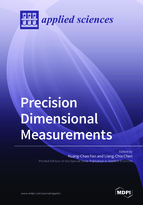Precision Dimensional Measurements
A special issue of Applied Sciences (ISSN 2076-3417). This special issue belongs to the section "Mechanical Engineering".
Deadline for manuscript submissions: closed (31 January 2019) | Viewed by 156245
Special Issue Editors
Interests: precision metrology; precision machine design; machine tool accuracy
Special Issues, Collections and Topics in MDPI journals
Interests: precision metrology; optical measurement; automated optical inspection (AOI); manufacturing; automation
Special Issues, Collections and Topics in MDPI journals
Special Issue Information
Dear Colleagues,
Precision dimensional measurements conventionally play a critical role in workshop quality control. Although there are many instruments on the market for a variety of measuring demands, such as lengths, angles, regular forms, free forms, special geometries, and 2D and 3D, in practice, however, not all products can be easily measured by current instruments and technologies. Sensors and precision stages for measurements are varied. Some cutting-edge manufacturing processes have produced many difficult-to-measure parts, such as complex geometry, mini-to-micro-sized, tight tolerance, high aspect ratio, large scaled, soft surface, etc. Some new measurement sciences and technologies are urgently needed to cope with these parts.
This Special Issue welcomes any papers revealing novel measurement methodologies and instrumentations for precision dimensional measurements of precision products, including new measuring machines, new sensors, on-machine measurements, on-line or in-situ measurements, micro/nano measurements, accuracy enhancement, error compensation, uncertainty analyses, etc. Detailed design principles in sciences, and technological applications in high-tech industries, are required in submitted manuscripts.
Topics may cover, but are not limited to, the following areas:
- Length measurements from macro- to micro- to nano-scales.
- Form measurements from 2D to 3D, from analytical to free forms, from small to large, etc.
- Design of new measuring machines for dimensional measurements.
- Optical measurements, such as triangulation method, image processing, confocal microscopy, white light microscopy, hybrid types, interferometers, etc.
- On-machine measurements, on-line or in-situ measurements
- New types of error compensation strategy.
Prof. Dr. Kuang-Chao Fan
Prof. Dr. Liang-Chia Chen
Guest Editors
Manuscript Submission Information
Manuscripts should be submitted online at www.mdpi.com by registering and logging in to this website. Once you are registered, click here to go to the submission form. Manuscripts can be submitted until the deadline. All submissions that pass pre-check are peer-reviewed. Accepted papers will be published continuously in the journal (as soon as accepted) and will be listed together on the special issue website. Research articles, review articles as well as short communications are invited. For planned papers, a title and short abstract (about 100 words) can be sent to the Editorial Office for announcement on this website.
Submitted manuscripts should not have been published previously, nor be under consideration for publication elsewhere (except conference proceedings papers). All manuscripts are thoroughly refereed through a single-blind peer-review process. A guide for authors and other relevant information for submission of manuscripts is available on the Instructions for Authors page. Applied Sciences is an international peer-reviewed open access semimonthly journal published by MDPI.
Please visit the Instructions for Authors page before submitting a manuscript. The Article Processing Charge (APC) for publication in this open access journal is 2400 CHF (Swiss Francs). Submitted papers should be well formatted and use good English. Authors may use MDPI's English editing service prior to publication or during author revisions.
Keywords
- Dimensional measurements
- Length measurement
- Angle measurements
- Form measurements
- 3D measurements
- Optical measurements
- On-machine measurements
- On-line measurements







